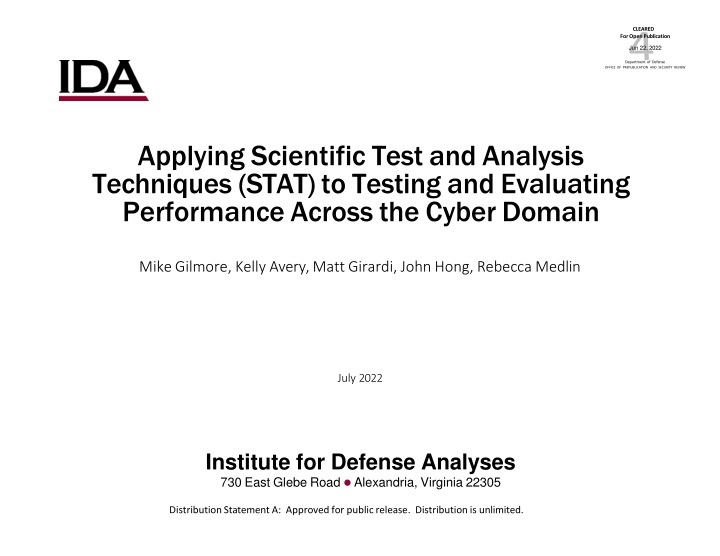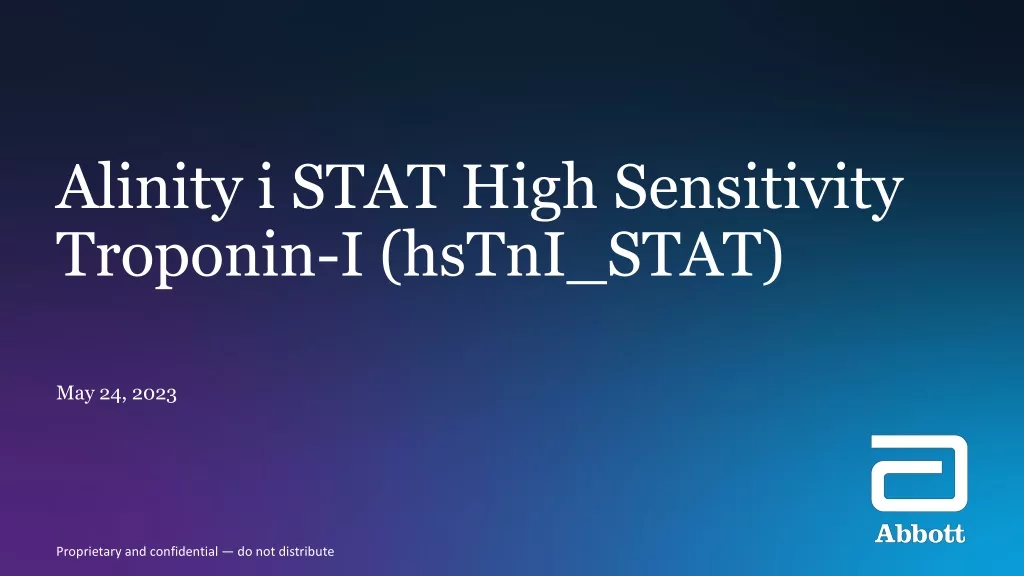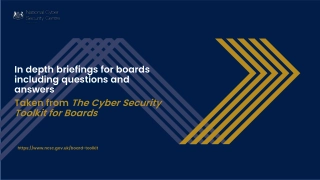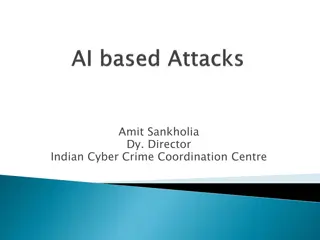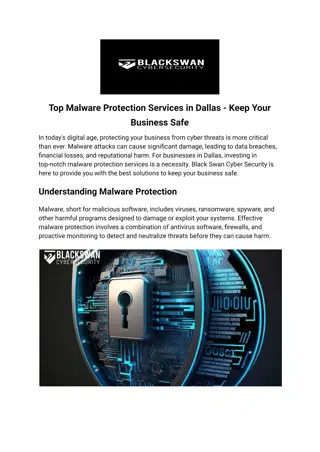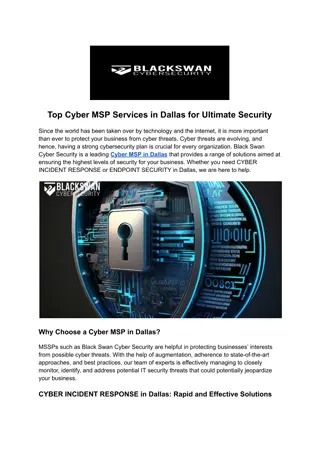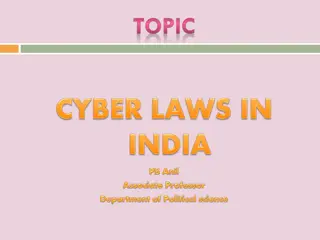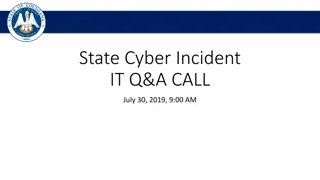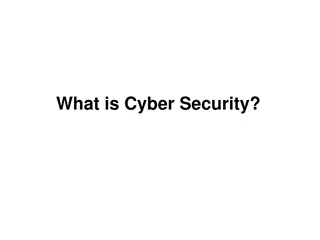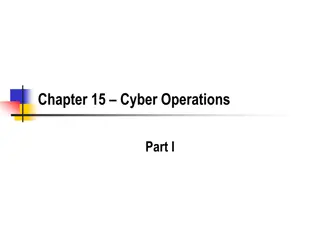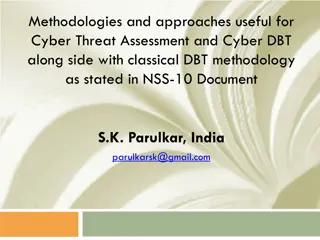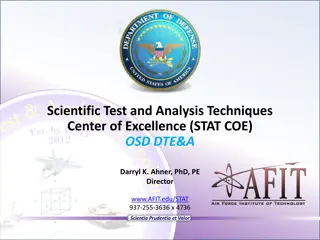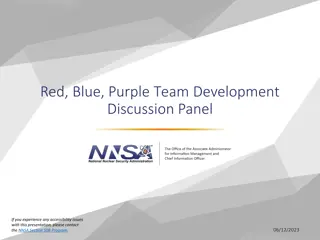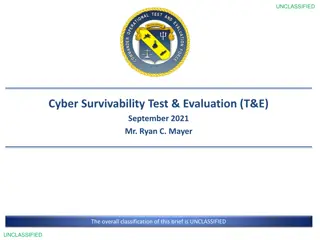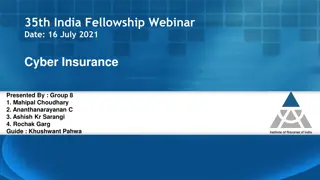Enhancing Cyber Performance Through STAT Techniques
Exploring the application of Scientific Test and Analysis Techniques (STAT) for evaluating cyber performance, this publication highlights the benefits of data-driven analysis in cybersecurity testing. The guidebook emphasizes efficient coverage of vulnerabilities, quantitative risk assessment, and structured evaluation processes to enhance mission assurance in the Cyber Domain.
Download Presentation

Please find below an Image/Link to download the presentation.
The content on the website is provided AS IS for your information and personal use only. It may not be sold, licensed, or shared on other websites without obtaining consent from the author.If you encounter any issues during the download, it is possible that the publisher has removed the file from their server.
You are allowed to download the files provided on this website for personal or commercial use, subject to the condition that they are used lawfully. All files are the property of their respective owners.
The content on the website is provided AS IS for your information and personal use only. It may not be sold, licensed, or shared on other websites without obtaining consent from the author.
E N D
Presentation Transcript
CLEARED For Open Publication Jun 22, 2022 Department of Defense OFFICE OF PREPUBLICATION AND SECURITY REVIEW Applying Scientific Test and Analysis Techniques (STAT) to Testing and Evaluating Performance Across the Cyber Domain Mike Gilmore, Kelly Avery, Matt Girardi, John Hong, Rebecca Medlin July 2022 Institute for Defense Analyses 730 East Glebe Road Alexandria, Virginia 22305 Distribution Statement A: Approved for public release. Distribution is unlimited.
Evaluating Performance Across the Cyber Domain The core of the emerging National Defense Strategy will include integrated deterrence, a framework for working across warfighting domains, theaters and the spectrum of conflict. * Thus, successfully executing Multi-Domain Operations (MDO) will remain key to the strategy. Enabling successful execution will include robust performance across the Cyber Domain, an important and increasingly contested part of MDO. Comprehensive and efficient cybersecurity testing will be needed to rigorously evaluate mission assurance across the Cyber Domain. *See https://www.defense.gov/News/News-Stories/Article/Article/2954945/integrated-deterrence-at-center-of-upcoming- national-defense-strategy/, accessed March 7, 2022 1 Distribution Statement A: Approved for public release. Distribution is unlimited.
How Can STAT Benefit Cyber Testing and Evaluation? The DoD Cybersecurity T&E Guidebook promotes data-driven mission- impact-based analysis and assessment methods for cybersecurity test and evaluation... In that regard, Scientific Test and Analysis Techniques offers: Efficient coverage of operational space and potential vulnerabilities consistent with limited resources and time Objective and quantitative determination of how much testing is enough and risks of insufficient testing Identification and statistical quantification of significant factors/vulnerabilities Quantitative evaluation of what is lost if rules of engagement (ROE) are too constraining and/or time is too short Addition of structure to previously ad hoc test events, thereby aiding comprehensive evaluation, while not eliminating free play 2 Distribution Statement A: Approved for public release. Distribution is unlimited.
Framework for Applying STAT (or for Planning any Test and Evaluation) Test & Evaluation requires collaboration Determine scope of test Questions you can ask about the system Subject Matter Expertise Identify appropriate metrics Analytical Expertise How you should measure system performance Identify factors that affect performance STAT tools can be applied at each step Types of data to collect, operational envelope Develop Test Design Quantity of data necessary, best resource allocation, objective plans Conduct the test Adjust test execution if necessary Analyze the data Structured mathematical data analysis plan appropriate for the design Draw conclusions Defensible risk assessments based on test results 3 Distribution Statement A: Approved for public release. Distribution is unlimited.
Determine scope of test Where/what are the potential vulnerabilities? Example 1 Using STAT to Help Structure a Systematic Cyber Assessment of a Hypothetical Processing System (PS) 4 Distribution Statement A: Approved for public release. Distribution is unlimited.
Hypothetical PSComprises 15 Subsystems; 2 Operations Consoles How can STAT help? 1 Subsystem 1 2 Subsystem 2 STAT can be used to--- 3 Subsystem 3 4 Subsystem 4 5 Subsystem 5 6 Subsystem 6 7 Subsystem 7 8 Subsystem 8 9 Subsystem 9 10 Subsystem 10 11 Subsystem 11 12 Subsystem 12 13 Subsystem 13 14 Subsystem 14 15 Subsystem 15 16 Operations Console 1 17 Operations Console 2 Initially guide systematic assessments in narrowing the number of subsystems to be tested* Aid structuring the final tests Aid analysis of test results *Potential venues include Cyber Table Tops (CTTs) and other Mission-Based Cyber Risk Assessments (MBCRAs) 5 Distribution Statement A: Approved for public release. Distribution is unlimited.
Structuring a Systematic Cyber Assessment of a Hypothetical Processing System (PS) --Attacks on Single Subsystems Narrow the Number of Potential Vulnerabilities --Attacks Spanning Multiple Subsystems 6 Distribution Statement A: Approved for public release. Distribution is unlimited.
Options for Design of PS Cyber Assessment--- Single Subsystem Attacks 1 Subsystem 1 2 Subsystem 2 3 Subsystem 3 4 Subsystem 4 5 Subsystem 5 6 Subsystem 6 7 Subsystem 7 8 Subsystem 8 9 Subsystem 9 10 Subsystem 10 11 Subsystem 11 12 Subsystem 12 13 Subsystem 13 14 Subsystem 14 15 Subsystem 15 16 Operations Console 1 17 Operations Console 2 Consider entry using Operations Consoles---2-level factor (Entry) Remaining subsystems are targets---15-level factor (Target) PS Option 1: Operations Console 1, Operations Console 2 for Entry (2) Remaining Subsystems are Targets (15) Nearsider and Insider Attack Postures (2) Native, Foreign Tools (2) 120 Total Combinations Consider 68 percent (minimal) and 80 percent power to correctly assess/identify vulnerabilities to subsystems (true positive) Consider 80 percent confidence of correctly excluding vulnerabilities (true negative) 7 Distribution Statement A: Approved for public release. Distribution is unlimited.
PS Design Options for Assessment--- Single Subsystem Attacks Attack Posture 15 Subsystems 15 Subsystems Target Subsystems Assessing 45 potential vulnerabilities covers 120 combinations with 68% power and 80% confidence; 65 assessments required for 80% power Distribution Statement A: Approved for public release. Distribution is unlimited. 8
Structuring a Systematic Cyber Assessment of a Hypothetical Processing System (PS) --Attacks on Single Subsystems Narrow the Number of Potential Vulnerabilities --Attacks Spanning Multiple Subsystems 9 Distribution Statement A: Approved for public release. Distribution is unlimited.
Software Faults versus Number of Interacting Parameters ~87% to 99% of faults involve 3 parameters ~60% to 96% of faults involve 2 parameters Source: Kuhn, D., et al, Practical Combinatorial Testing, October 2010, available at https://nvlpubs.nist.gov/nistpubs/Legacy/SP/nistspecialpublication800-142.pdf, accessed January 14, 2022. PARAMETER = Input Data OR Configuration Treat Subsystems spanned as a Configuration 10 Distribution Statement A: Approved for public release. Distribution is unlimited.
Options for Design of PS Cyber Assessment--- Attacks Spanning Two Subsystems Suppose: Assessment of single subsystems described previously narrows focus to 8 subsystems for initial insider (only) penetration/attack through Operations Console 1 or 2; but--- Concern exists regarding attacks spanning more than one subsystem Consider attacks spanning those 8 subsystems and any one of the other 15-1 with the tool(s) used unspecified, but assumed to be those most applicable in each case as determined by prior assessment (e.g., specific native or foreign) PS Option 2: Operations Console 1, Operations Console 2 for Entry 8 Subsystems are first Targets (Target Subsystem 1) 14 Subsystems are second targets (Target Subsystem 2) Insider Attack Posture Most Applicable Tool 224 Total Combinations (2x8x14) 11 Distribution Statement A: Approved for public release. Distribution is unlimited.
PS Design Options for Assessment--- Attacks Spanning Two Subsystems 15 Subsystems Target Subsystem 1 8 Subsystems Assessing 50 potential vulnerabilities covers 224 combinations with 68% power and 80% confidence; 65 assessments for 80% power 12 Distribution Statement A: Approved for public release. Distribution is unlimited.
PS Design Options for Assessment--- Attacks Spanning Three Subsystems Suppose Further: Assessment of two-subsystem combinations narrows focus to 6 subsystems as second targets; but--- Concern exists regarding attacks spanning up to three subsystems Consider attacks spanning the identified 8 first targets, 6 second targets, and any one of the remaining 15-2 subsystems PS Option 3: Operations Console 1, Operations Console 2 for Entry 8 Subsystems as first Targets (Target Subsystem 1) 6 Subsystems as second targets (Target Subsystem 2) 13 Subsystems as third targets (Target Subsystem 3) Insider Attack Posture Most Applicable Tool 1248 Total Combinations (2x8x6x13) 13 Distribution Statement A: Approved for public release. Distribution is unlimited.
PS Design Options for Assessment--- Attacks Spanning Three Subsystems 6 Subsystems Target Subsystem 1 8 Subsystems Target Subsystem 3 15 Subsystems each vertical band Assessing 55 potential vulnerabilities covers 1248 combinations with 68% power and 80% confidence; 70 assessments for 80% power Distribution Statement A: Approved for public release. Distribution is unlimited. 14
Framework for Applying STAT (or for Planning any Test and Evaluation) Test & Evaluation requires collaboration Determine scope of test Demonstrated Questions you can ask about the system Subject Matter Expertise Identify appropriate metrics Analytical Expertise How you should measure system performance Identify factors that affect performance STATtools can be applied at each step Types of data to collect, operational envelope Develop Test Design How might this work? Quantity of data necessary, best resource allocation, objective plans Conduct the test Adjust test execution if necessary Analyze the data Structured mathematical data analysis plan appropriate for the design Draw conclusions Defensible risk assessments based on test results 15 Distribution Statement A: Approved for public release. Distribution is unlimited.
Applying the Framework to Cyber T&E (Steps 2 - 3) Objectives--- Cooperative test attempt to comprehensively identify vulnerabilities and validate exposures in system Adversarial test using the results of the cooperative test in as realistic setting as appropriate, assess system/users to protect, mitigate, and restore when faced with various types of cyber threats Potential response variables--- Attack thread length/number of steps Level of threat capability required to achieve action (Nascent, Limited, Moderate, Advanced) Severity of mission effects (None, Low, Med, High) (AA only) Time to detect / mitigate / restore Time to penetrate / achieve effect Examples of many possibilities Potential factors--- Protocol or objective (Web application, servers, interfaces with other systems, etc.) Type of cyber effect (Confidentiality, Integrity, Availability) Starting posture (Outsider, Near-sider, Insider) Tool Type (Native, Foreign) System load/Number of users (Low, High) Level of defender participation (Users only, Users + local defenders, Users + local + CSSP) 16 Distribution Statement A: Approved for public release. Distribution is unlimited.
Applying the Framework to Cyber T&E (Steps 2 3) Consider a sequential approach First stage -- screen for potential vulnerabilities Second stage refine test, characterize significance of factors and interactions in greater detail Cyber/system SMEs should determine which interaction effects are likely/interesting, which specific response variables are most meaningful Create design first, then update based on specifics, such as rules of engagement (ROE) and disallowed combinations, while considering tradeoffs Enables effects/constraints of ROE to be understood Could include ability to control for learning effects over time Would need to randomize to the extent possible and collect enough data to be able to include coefficients for time and person in the model 17 Distribution Statement A: Approved for public release. Distribution is unlimited.
Applying the Framework to Cyber T&E (Steps 2 3) A model is fit to data to form an empirical relationship between the response variable and factor settings for the purposes of: --Determining which factors have a large effect on the response --Making predictions across the factor space (including combinations that were not explicitly tested) --Quantifying uncertainty in test results Responses: Time to get in/achieve effect, Thread length, Level of threat required, Time to detect/mitigate/restore, Severity of mission effects One such model could be: y S D f E Normally-distributed error Estimated model coefficients While the model is linear in its parameters, the factors/responses are not necessarily linear or normal: Time-based responses are likely right-skewed, so lognormal regression or a survival model may be appropriate The mission effects response is categorical so a multinomial logistic regression is one appropriate modeling choice The test could be designed to allow the ability to include additional recorded factors (e.g. tool/method, time) in the model and estimate their effects 18 Distribution Statement A: Approved for public release. Distribution is unlimited.
Develop Test Design Example 2 Hypothetical Command and Control (C2) System 19 Distribution Statement A: Approved for public release. Distribution is unlimited.
Hypothetical C2 System P 1 P 2 P 3 P = Protocol User 1 User 2 Application Server Data Base External Systems E-System 1 E-System 2 E-System 3 E-System 4 E-System 5 E-System 6 E-System 7 E-System 8 E-System 9 E-System 10 E-System 11 E-System 12 E-System 13 E-System 14 Web Server P 4 P 5 Directly Connected External Systems D-System 1 D-System 2 D-System 3 D-System 4 D-System 5 D-System 6 P 6 P 7 Maintenance Protocols = Protocol/Entry Point = Objective 20 Distribution Statement A: Approved for public release. Distribution is unlimited.
Design for Cooperative Test (1 of 2) Create a design using the 5 varied factors presented earlier For the cooperative test, cover the space of all entry point/protocol combinations (an 8-level factor) Focus on main effects Can choose more than the minimum number of runs enabling additional covariates to be included in the statistical model during analysis Forty runs (attempted penetrations) chosen as an example, but more usually better 21 Distribution Statement A: Approved for public release. Distribution is unlimited.
Design for Cooperative Test (2 of 2) The resulting 40 run design provides coverage (albeit sparse) of the 8 X 3 X 3 X 4 = 288 factor space 22 Distribution Statement A: Approved for public release. Distribution is unlimited.
Cooperative Test Measures of Merit The design is sufficient to provide high power to detect large differences (SNR=2) in main effects with 80% confidence There is necessarily some aliasing in the design, but it is mostly among higher order terms. Correlations between main effects are very low and not a concern Term Power 0.77 0.99 0.99 1.00 1.00 Protocol/Entry Point Starting Posture Level of Defender Participation Tool Type Network Load/Traffic No major confounding between factors 23 ution is unlimited. Distribution Statement A: Approved for public release. Distrib
Analyze the data Analysis How it Might Work 24 Distribution Statement A: Approved for public release. Distribution is unlimited.
Example Analysis of a Continuous Response Variable Native Foreign Low High Starting Posture Outsider Nearsider Insider Maintainence Protocol P7 Protocol / Entry P6 Execute the Test P5 Point P4 P3 P2 Capture the Data P1 Test Point to Execute Level of Defender Part. Level of Defender Participation Notional distribution of the continuous response variable collected from the 40 test points 25 Distribution Statement A: Approved for public release. Distribution is unlimited.
Example Analysis of a Continuous Response Variable After executing the test, we can perform an exploratory analysis. Observations considering three of the factors include Native Tools appear to have higher responses than Foreign Tools, as do Insider Attacks. There also appear to be some differences in responses across the Protocols. Response Legend High Notional Continuous Response Variable Tool Type Low 8 Protocols Observed Response Protocol / Entry Point 26 Distribution Statement A: Approved for public release. Distribution is unlimited.
Example Analysis of a Continuous Response Variable Our test design enables us fitting the statistical model as a function of the design factors y S D f E Observed Response From the model fit, we see that some factors have an effect on the Notional Continuous Response Variable Statistical difference between Statistical differences also exist between some of the Protocols Native and Foreign tools ---and--- Starting Postures Notional Results Notional Results Estimated Mean Estimated Mean We can summarize the results using the point estimate and confidence intervals Native Foreign Outsider Nearsider Insider 8 Protocols Protocol / Entry Point Tool Type Starting Posture 27 Distribution Statement A: Approved for public release. Distribution is unlimited.
Back-up 28 Distribution Statement A: Approved for public release. Distribution is unlimited.
PS Design Options for Assessment--- Single Subsystem Attacks Attack Posture 15 Subsystems 15 Subsystems Target Subsystems Assessing 65 potential vulnerabilities covers 120 combinations with 80% power and 80% confidence Distribution Statement A: Approved for public release. Distribution is unlimited. 29
PS Design Options for Assessment--- Attacks Spanning Two Subsystems 15 Subsystems Target Subsystem 1 8 Subsystems Assessing 65 potential vulnerabilities covers 120 combinations with 80% power and 80% confidence Distribution Statement A: Approved for public release. Distribution is unlimited. 30
PS Design Options for Assessment--- Attacks Spanning Three Subsystems 6 Subsystems Target Subsystem 1 8 Subsystems Target Subsystem 3 15 Subsystems each vertical band Assessing 70 potential vulnerabilities covers 1248 combinations with 80% power and 80% confidence 31 Distribution Statement A: Approved for public release. Distribution is unlimited.
